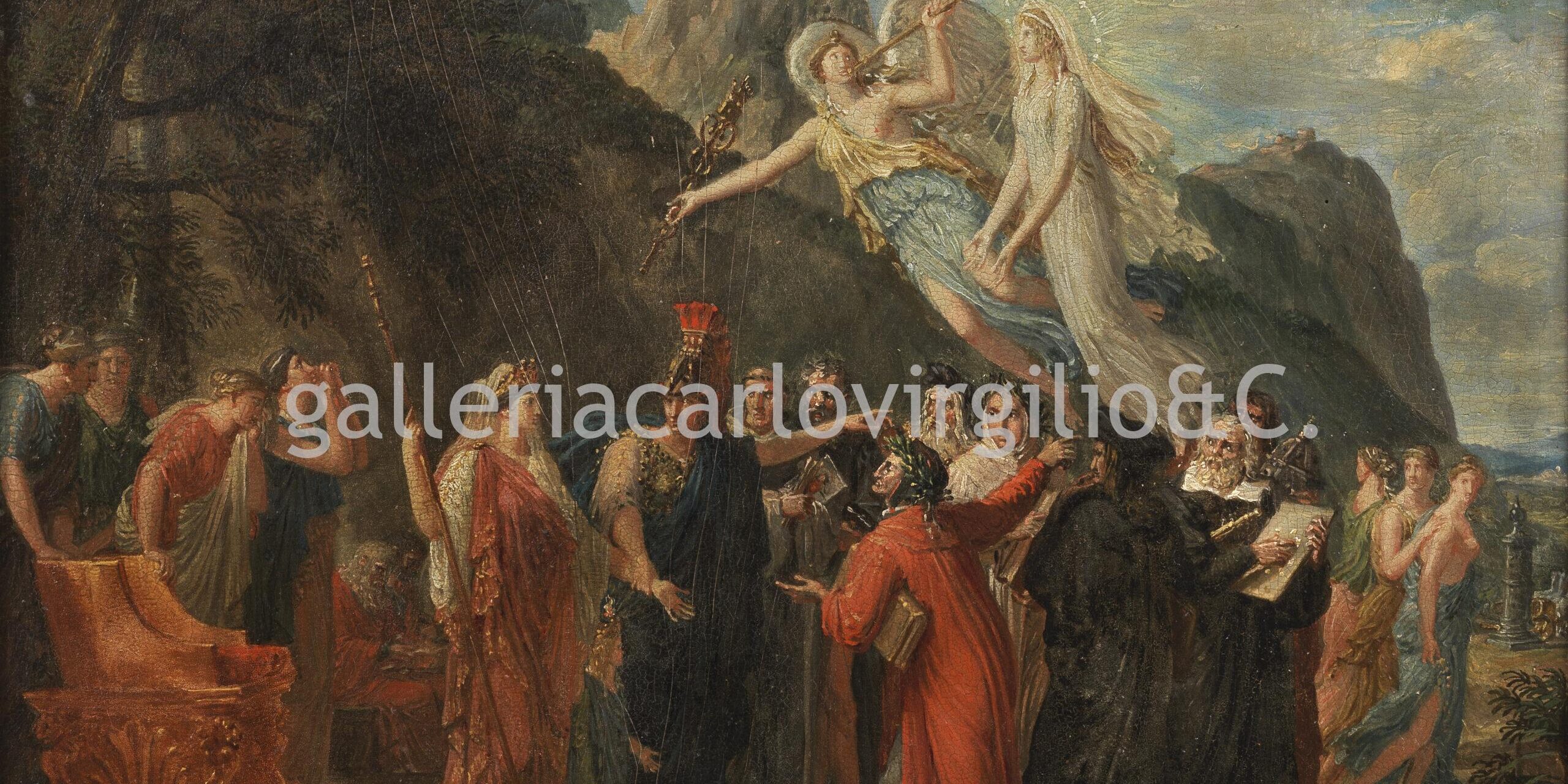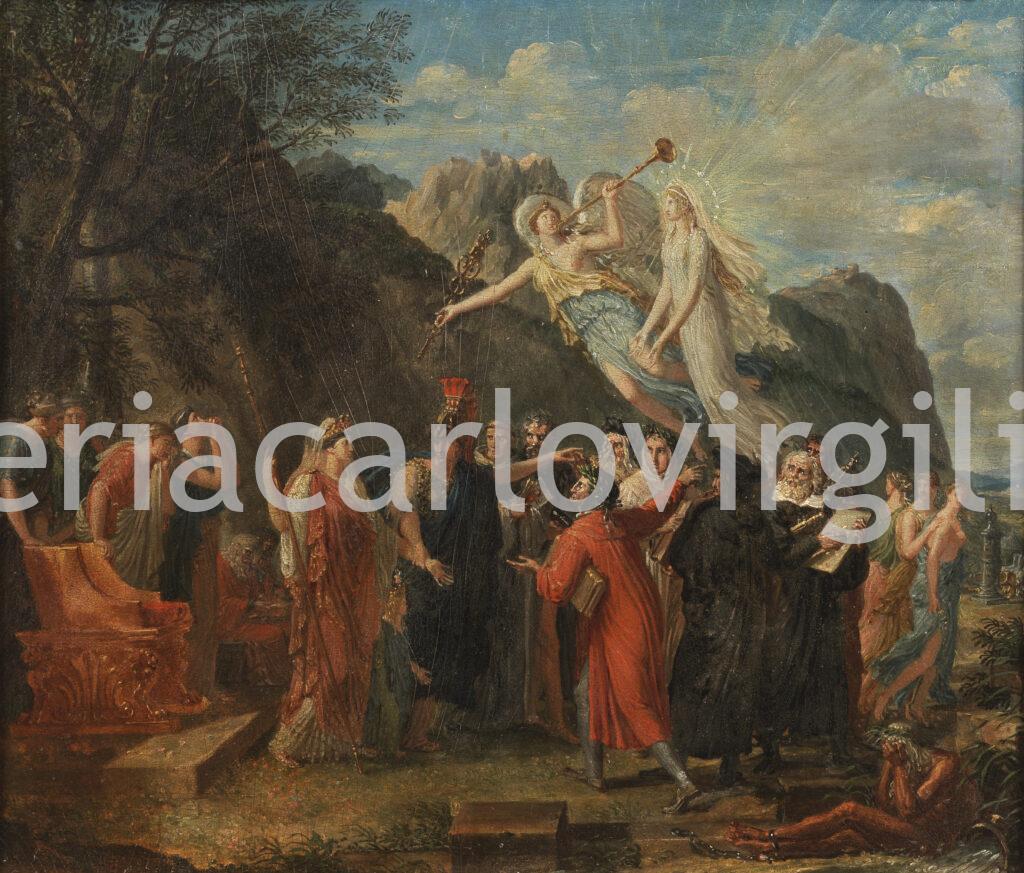| NOT AVAILABLE

Jean-Baptiste Frédéric Desmarais
Paris 1756 – Carrara 1813
Illustrious Tuscans invite Elisa Baciocchi to the Government of the Duchy • 1809
oil on panel, 50 x 56.5 cm
Fragment of inscribed label on the back: “[…] Bartolomeo di S. Marco/Michell’A[…]/Leonardo da Vinci/9 Galileo/ 10 Machiavelli/ 11 Le Grazie/12 Il Senatorio […]/Trono/13 Le D[…] di Corte affl[…]/ 14/ La Fama con Beatrice/15 Il Fiume Serchio incatenato […]”
In this singular Napoleonic allegory we recognise Elisa Baciocchi, dressed in the stately drapes of an ancient and crowned as in the portraits of Marie-Guillemine Benoist (1806, Lucca, Museo di Palazzo Mansi) and Guillaume Guillon Lethière (Versailles, Musée National du Château). Against a background of the Apuan Alps she advances solemnly – accompanied by her daughter Elisa Napoleona and preceded by Minerva – leaving the throne of the principality of Lucca and Piombino. Venerable senators are intent on transmitting her legislative reforms, while the ladies of the court appear as mourners, as does River Serchio as he lies chained and regimented by new banks and drainage.
Hence Elisa is concluding a period of good governance and splendid promotion of the arts, court manufacturers and artistic teaching in Carrara, which she had endowed with illustrious foreign teachers and the ateliers of Banco Elisiano dedicated to the production of series of Napoleonic portraits.
The illustrious Tuscans, Fra Bartolomeo, Michelangelo, Dante, Leonardo, Petrarch, Machiavelli, Galileo and Brunelleschi with the attribution of the cupola, are inviting her to move towards grander destinies, in the direction of Florence. The cortège is preceded by the three figures of the Graces, civilizers of mankind, while Fame flies through the air holding out the sceptre of the Grand Duchy of Tuscany, and the angelic figure of Beatrice alludes to the divine plan of the investiture.
The sketch, a modelletto on panel, shows the style of Jean-Baptiste Frédéric Desmarais in the characteristic lengthening of the figures and the dense linear flow of the drapery. The artist, all “French fire” as defined by his Pistoiese pupil Niccola Monti, was popular for his rapid studies. Melchior Missirini recalled him as “powerful in invention and layout,” and superior in sketches than finished works.
So Desmarais was used to engaging, as here, in the area of allegorical invention. He was also directly linked to Elisa and her court, having been appointed painting professor and drawing master at the Eugeniana Academy of Carrara.
Awarded his Roman artistic scholarship with the painting of Horace Killing his Sister Camilla (Paris, École des beaux-arts; sketch in Montpellier, Musée Fabre), the artist arrived in Rome in 1786, sending back to his homeland paintings such as The Shepherd Paris (private collection) and Pindar Dying in the Arms of Theoxena, admired by Goethe. In 1793, he fled to Florence after the assassination of General Duphot, with his compatriots Boguet, Fabre, Gauffier and Gagneraux, where he encountered mixed fortunes. In 1794, Wicar denounced him as a reactionary at the Société populaire des arts, alongside Gauffier, whose daughter Faustina he later adopted in 1801. After working for the alabaster establishment Inghirami of Volterra, and taking commissions such as the Deposition of John the Baptist for Pisa (St. Giovanni in Spazzavento), the Portrait of the Roncioni Family (Pisa, Palazzo Blu), and the fresco cycle for the Tolomei family with Boguet, now lost (Roberto Giovannelli, “Jean-Baptiste-Frédéric Desmarais e Nicolas-Didier Boguet, vorreste voi uscir dal muro? Pistoia, gli affreschi in Palazzo Tolomei”, in Orizzonti del MO.C.A. Riflessioni tra moderno e contemporaneo, a cura di Roberto Giovannelli, Leghorn 2022, pp 64-71), in 1797 he was appointed assistant professor at the school of nudes at the Academy of Florence, later counting Bezzuoli and Nenci among his pupils.
With the advent of Napoleon his relations with his native country improved. And when Elisa was looking for teachers for the Academy of Carrara, her informers told her “in Florence he enjoys one of the finest reputations and is numbered among the first four painters of the Tuscan Academy.” His recent paintings gave proof “of his singular genius for invention, as in both colour and drawing too” (Arch, di Stato di Lucca, Segr. Di Stato, vo. 199, n. 133, cit in Olivier Michel, Desmarais, Jean-Baptiste-Frédéric, in Dizionario Biografico degli Italiani, vol. 39, 1991, ad vocem).
As a result, in 1807 he was appointed master at Carrara (and then vice president of the Academy and vice director of the Museum), counting among his pupils soon-to-be-famous sculptors such as Carlo Finelli, Ferdinando Fontana, Raimondo Trentanove, Alessandro Triscornia and Pietro Tenerani; so devoted to their master that they made his bust for the Academy.
In 1808, he designed a monument to Elisa of which Marmottan saw the sketch in 1898 in the library at Villa Vicentina, Trieste, Elisa’s last home, with the sovereign enthroned, next to Minerva and the three Sister Arts (Paul Marmottan, Les arts en Toscane sous Napoléon: la princesse Élisa, Paris 1901, p. 82).
On 3 January of the following year, for the sovereign’s birthday and at the instigation of Hector Sonolet, director of Banco Elisiano, Desmarais composed an “esquisse allégorique représentant “les grands hommes de la Toscane appelant Son Altesse à les gouverner”. It is again Marmottan who reports a note signed by Desmarais and Sonolet dated 2 January and found in the Massa Archive (dossier Banca Elisiana, cit in Marmottan, Les arts, cit., pp. 202-203, n. 1), accurately describing the composition of the recovered modelletto, and so providing significant evidence of the Napoleonic allegorical iconography: “Voici comment en était conçue l’ordonnance. Élisa quitte le trône de Lucques et, guidée par Minerve, se rend aux vœux des Florentins. Dans un coin, la cour de Lucques pleure son départ près du Serchio enchaîné”
Stefano Grandesso
The Carlo Virgilio & C. Gallery searches for works by Desmarais Jean-Baptiste Frédéric (1756-1813)
To buy or sell works by Desmarais Jean-Baptiste Frédéric (1756-1813) or to request free estimates and evaluations
mail info@carlovirgilio.co.uk
whatsapp +39 3382427650
